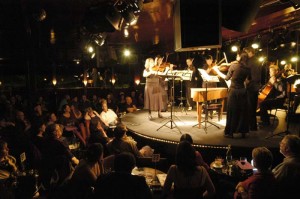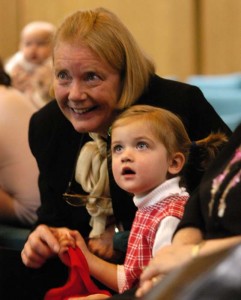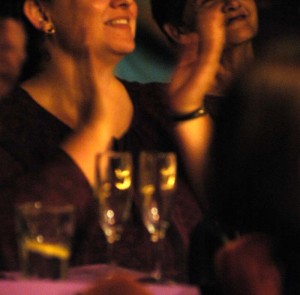[Now we come to the changes Nicole Canham made, which drew such an explosion of new people when she was artistic director of the Canberra International Music Festival.]
[In part one of her post, she told us why changes were needed. And why she also continued the festival’s older programming, because, as she says:
Something I’ve observed and find difficult to understand is why in our discourse there isn’t more tolerance for integrating both the best of traditional practice with a realistic understanding of contemporary culture. It has been my experience that these two approaches, rather than having to compete with each other, can be combined to create a more exciting and alive framework for sharing classical music.
[And now we come to the crucial part of her two-part post: The changes she made, changes that were so strongly successful.]
Some of the concerts were new for the festival, but not necessarily that unusual: in 2005 I programmed a performance of Bach’s Coffee Cantata in an iconic, beautiful, European-style coffee house.
One year, the handing down of the national budget occurred during the midst of our festival, so I programmed a concert we called Budget Blues, brought in a fantastic trio who performed mostly jazz standards on ukulele, drums and tea chest bass in the Parliamentary Members Lounge of the Old Parliament House. (If you’re curious about what a tea chest bass is – well, it’s a bass made from an old wooden tea chest, with a broomstick and a piece of string attached to it. Here’s a performance by the Old Spice Boys on YouTube.) I also programmed many more events for families – a baby Mozart concert in my first year, which we followed up in my second year with Carnival of the Animals.
In 2007 we had great fun with a family concert of the Mozart Toy Symphony, where we invited the audience, largely families as you would expect, to bring their own toy instruments along. There were people with all kinds of plastic whistles, rattles, even guitars (!), and one little boy whose dad had made him a trumpet-like horn with a piece of garden hose. We invited a few kids with more unusual instruments up on stage to perform with us, including the little boy with the hose, and he was just delighted. For me, there was no difference in value in the enjoyment of an audience listening to music in silence, and the delight of that child (who had also just listened to the Mozart) having the opportunity to come up on stage and join in.
I increased our partnerships with many of Australia’s national cultural institutions and made stronger links to their exhibitions and collections, which added richness and depth to the concert experiences on offer. We presented screenings of Felix the Cat cartoons at the National Film and Sound Archive, with new commissions of live musical accompaniment, and we held annual Promenade Concerts in the National Gallery of Australia, where performers and ensembles in different parts of the gallery presented intimate 15 minute mini-concerts. And we presented a concert of Dutch music and a viewing of early Dutch maps of Australia at the National Library.
Two personal highlights for me were a work I commissioned in 2007, called the Canberra Cantata, for which I engaged a local composer/cabaret artist to create a work that was all about Canberra, starring a range of varied Canberrans. We held a lyrics competition in elementary schools, for which kids submitted poems about what they loved about the city, and we featured local performers, events and in-jokes. (Canberra has a lot of roundabouts [“traffic circles” in the US], so we had a song about that). As Canberra is the capital of Australia it’s the home to all of the international embassies. The festival had often presented concerts in embassy residences, but I went a little further, and with the help of the diplomatic community I put together a wonderful choir of singing ambassadors, which brought the house down. They had to give an encore in the middle of the performance!
The second big highlight was the education program I created, which in the 2008 festival saw 25% of Canberra elementary school children attend a concert of music by living Australian and American composers, at one of our national cultural institutions, presented by some of our headline artists. These two achievements — the singing ambassadors and the education program — really captured things closest to my own heart: a strong connection to time and place, and a way to involve a wide range of artists and audiences in great music.
From an overall point of view, what I did was quite simple. I committed to programming one dozen core concerts in each festival that our “typical” subscriber might enjoy. But beyond that, everything new I programmed was for other people and I had no expectation that our core subscribers would attend these new events, although many of them chose to do so. This enabled me to create many kinds of events, including those referred to above, plus late-night concerts for a younger audience and many more performances of new music. The definition of chamber music was expanded, so that it meant music played in intimate settings, but not restricted to the classical chamber music repertoire. This included some jazz and world music, some cabaret-style shows and one or two hybrid works I commissioned.
What is interesting is what happened through this opening up of the festival. By 2008, 7 out of 10 people were experiencing the festival for the first time or had only been once or twice before. Attendance had increased tenfold in four years — we had grown a completely new audience.
When we talk about building audiences people so often we seem to be talking about building more of the same kind of audience. What I chose to do in Canberra was to take the opposite approach, so that everything new that I created was for people who did not fit the profile of our core subscribers (who were white, affluent, and over 50 years old). As our attendance showed, there was no shortage of new audience members willing to come and join us, including many more children, families, and people younger than 50.
This new audience brought a great deal of energy and enthusiasm to the festival, creating genuine excitement about premieres of new work, and also pride and greater involvement in the process of making that happen. Lisa Moore, an Australian pianist, based in New York, was very involved in the 2008 festival as guest curator of some of our new music concerts, and had the great idea of incorporating a young composer’s competition. In the first year of that competition, we didn’t have any money to offer a cash prize. Composers did have their travel expenses paid, so they could attend the premieres of their work, and they also got a recording, and had a chance to give a lunchtime talk and meet members of their audience.
After one of these talks, a couple in the audience came forward and wanted to offer a cash prize to our winning young composer, because they were so impressed with her work, and with the idea of the competition. This couple have since increased their contribution to the festival each year and are now significant festival patrons.
When we fear the results of opening up what we do to broader audiences, we don’t always do the music a service. This was proven to me many times, no more so on my last day of my last festival, which Lisa Moore programmed as a music marathon. With some of my colleagues, I gave a performance of Messiaen’s Quartet for the End of Time, at which the audience was so quiet that you could have heard a pin drop. That is a concert that will remain with me, the feeling of how focused everyone was – performers and audience alike – in a day full of all kinds of music, finishing with Steve Reich’s Drumming.
The idea of the common thread, of music being a language that transcends boundaries, brought the program and those audiences together – as opposed to the idea of something exclusive, pristine and only for the musically educated. I haven’t reflected much on my time with CIMF since I finished in 2008, but looking back at the results, I’m proud of what I achieved. It was also not really that difficult to achieve, largely because I created partnerships and collaborated with others in the most attentive way that I could. Having your major stakeholders on your side makes a big difference to what is possible! Finding ways to work together, rather than to hope that everyone might eventually bend to a single minded artistic vision or set of traditions, was a big part of that. Partnerships are not simply an exchange. They are a collaborative framework ,and within that frame flexibility and creativity are often required.
After four years, however, it was time for me to move on and to get back to developing new directions and projects in my own artistic work. I found myself frustrated with hearing so many other colleagues, in leadership positions similar to mine in Canberra, talking about how impossible it was to develop new initiatives due to insufficient resources of money or time. Although I appreciate the organizational difficulties involved — having had a role where I was both Artistic Director and General Manager of a small arts organization — I think the main resource required was will power and conviction. I think people who truly care about bringing new audiences to classical music, or to new music, or to any other kind of music for that matter, will simply find a way.
Nicole Canham is an independent professional musician (clarinet and targato), festival director and creative producer specializing in chamber music and collaboration. Nicole has performed around Australia, in the USA and the UK, and in Mexico, Belgium and France. Nicole is a doctoral candidate at the University of Queensland. From 2005-2008, she was Artistic Director of the Canberra International Chamber Music Festival. Nicole is a Churchill Fellowship recipient, and was ACT Artist of the Year (2008), State Finalist, and Telstra Young Business Woman of the Year (2007) and has served as a board member for Canberra Arts Marketing and ACT Cultural Council. Her platform paper, Democracy versus Creativity in Australian Classical Music is published by Currency House Press. You can read her blog here.




BRA-VO NICOLE!
I believe you are the perfect example of empowering the MUSICIANS to direct “New Classical” innovations rather than artistic administrators or even career music directors. And your facilitation of collaborations with new audiences proves that bridges must flow in BOTH directions to work. I’m creating similar opportunities with my own works (although on a much smaller scale) and hope you’ll continue to ply these waters wherever you go. Classical music is a living, breathing and adaptable legacy for humanity; not some immovable monument on a grave. I’ve come to believe that it’s easier for newer and smaller organizations to adapt than the establishment majors, which fears it has much to lose. In fact, I left one such to be able to adapt classical fully independently and I’d love to collaborate with you someday.
Thanks Rick for your enthusiasm – and I couldn’t agree more with you in terms of musicians themselves taking charge of creating the change they would like to see! We seem very often to be fed the organisational perspective when discussing the challenges of classical music. In reality we all have opportunities to make a difference, and it was such a great feeling for me to see that festival audience grow and include so many new faces. That was absolutely about creating a two-way approach to programming as you point out, and it is so great to hear from others about the work they are doing in this area, too. Would love to collaborate some time.
Well, I’ve actually arranged nearly a hundred famous symphonic works for The Soldier’s Tale instrumentation plus flute. It’s been the PERFECT way to introduce remote and new music lovers to the symphony. It’s intimate, flexible and rich! It also let’s me feature each instrument with some solo turns… because I developed my Finale skills to the level of 2nd nature. Indeed the ability to ADAPT classical comfortably is another key to showing this music is living, breathing. Check some out CutTime Players tracks like Till Eulenspiegel by clicking on my name!
Nicole- you rock! “Finding ways to work together, rather than to hope that everyone might eventually bend to a single minded artistic vision or set of traditions”- So powerful
Keep talking, keep writing, keep giving (sure we’ll wear you out- especially here in Australia!), keep inspiring, because classical music needs you.
Thanks
Kathleen, thanks so much for your encouragement. It is always heartening to encounter like-minded people!
Nicole…I’m so inspired by your posts. I just discovered Sandow’s blog and your posts are the first to my inbox. I just graduated with a Master’s Degree in voice performance in Canada and the most liberating moment of my life what when I fully acknowledged that I don’t want a traditional “career”, instead I want to figure out ways to bring this incredible music to new audiences in new spaces – all the while making interesting opportunities for myself. I keep telling people that the traditional format of presenting classical music is just not working to attract new audiences, so to read your words was so motivating! We must evolve! Thanks for the inspiration!!
Caroline, welcome! So glad you liked Nicole’s posts. From the moment Nicole first told me what she did in Canberra, I knew I wanted to share it with the world. And your reaction shows why. I hope you’ll come back next week, when another guest blogger — a singer like you — will tell her story, about embarking on a project all on her own, and hoping to reach a new audience. So glad you found the blog!
Caroline, what an exciting time for you. I remember my own particular turning points along the same lines you write about and they are indeed powerful moments of liberation. Cherish that enthusiasm you have and really nurture it – it is a rewarding, unusual and sometimes surprising journey in the world of building new audiences and doing things in alternative ways. Go for it 🙂
Thanks so much Nicole! Yes, it is such an exciting time – terrifying, but exciting 🙂 However, the most fulfilling experiences I’ve ever had in my life – musical and non – have been the ones that scare me the most. From premièring new works, to having the courage to say that my definition of success is very different from the rest of the pack, I know that I’ve chosen a direction that’s right for me and will bring incredible classical music to new ears! Bravo to you and thanks again for such an inspiring post!
Greg having read the Nicole Canham posts I find myself frustated by the fact that there seems to be no connection between you and Mark O’Connor who just recently compose the first improvised violin concerto. The concerto is fully scored for orchestra but the solo violin part must be completely improvised. Think about it the concerto could be performed one hundred times and each performance would be definitive.
He and I know about each other, and have a close colleague in common. At some point I’m sure our paths will cross. I love the idea of an improvised concerto.
Greg I should have stated it better. I really believe the two of you should be working together. I’m sure he’s bringing in a new audience to classical because of his crossover, his compositions and his O’Connor Method of teaching string instruments. If nothing else he ought to write a Blog article for you.
Nicole’s account of things rings true to me, because I was there. What she hasn’t quite said is that she won her board over to her ideas because of her refreshing personality, conviction and ideas — and they worked hard in support of her vision. She also convinced a person of means to support the Festival financially, and that gave the new directions a huge impetus.
Thanks Rick I went to You Tube and listened to what you have done with fellow players from the Detroit Symphony to bring classical music to new audiences. I really think that you are doing something very significant. You are in the right place doing the right thing. Not everyone believes in God. I happen to. Whatever we find he wants us to make it better than we found it. You are certainly doing that!!!
I appreciate your strong encouragement Kenneth! Stepping outside of the comforting tower of artistic segregation, we face curious audiences with REAL symphonic music. This is our art now. We can also teach what we learned for others to do even better. CutTime®, the compositions and our RAP are meant to form a smooth on-ramp for new audiences.